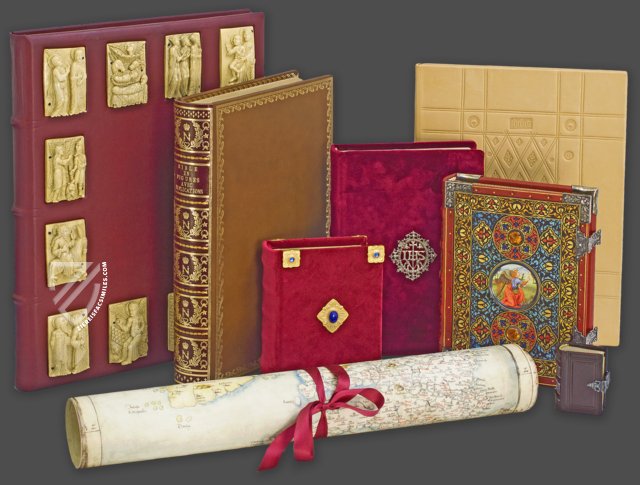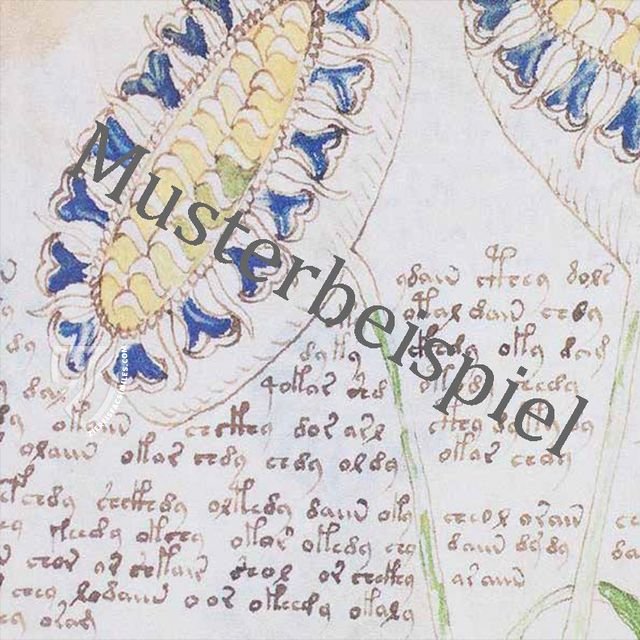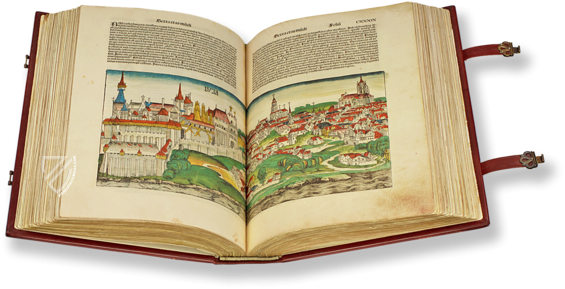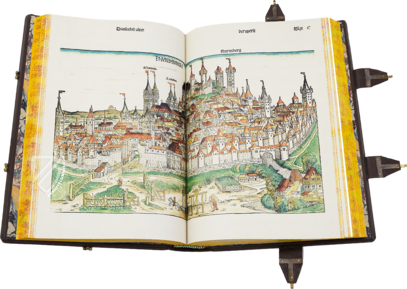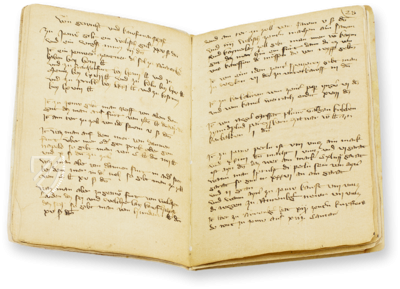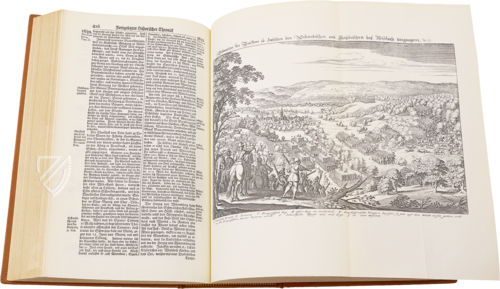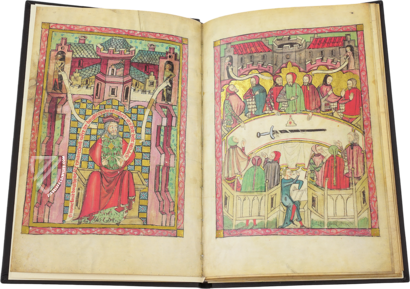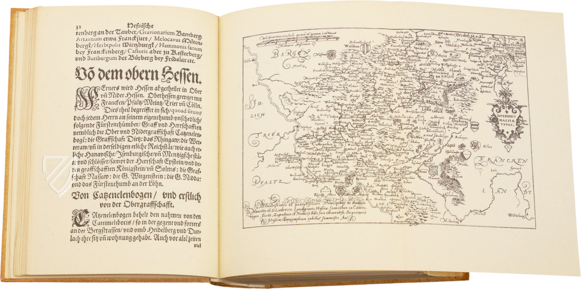Chronicle of the Holy City of Cologne
(1,000€ - 3,000€)
Johann Koelhoff the Younger was a grocer turned printer during the late incunabula period. The most important work he published also bears his name, the Koelhoff Chronicle, which originally had the Low German title Die Cronica van der hilliger Stat van Coellen or “The Chronicle of the Holy City of Cologne”. Written by an unknown author, this annal is illustrated with 368 woodcuts in a manner similar to Hartmann Schedel's Nuremberg Chronicle. Published on August 23rd, 1499, in an edition of about 250 copies, it was banned only three months later because of the harsh criticism levelled by the anonymous author at both secular and religious leaders.
It is the first comprehensive history of the city of Cologne, spanning all of history from Creation to the end of the 15th century and is considered to be one most important and compact universal historical works of the Late Middle Ages. The information it contains about the city from the middle of the 15th century onwards is reasonably reliable. Although most of the originals of this incunabulum are incomplete and many were poorly colored, one complete and uncolored copy has survived and served as the template of this fine facsimile edition.
Chronicle of the Holy City of Cologne
In the 13th century, Cologne was the largest German city with 20,000–25,000 inhabitants as well as being an important center of trade and a popular pilgrimage destination after the relics of the Magi were brought there in 1164. At the time of the publication of this work in 1499, Cologne had reached the pinnacle of its greatness before losing its economic supremacy during the 16th century. This chronicle of the city, which was the brainchild of Johann Koelhoff the Younger (d. 1502) but written by an unknown author, probably Johann Stump, a schoolmaster from Rheinbach, is one of the most compact works of universal history from the Late Middle Ages.
Most of the text up to the year 1445 is a compilation of sources copied verbatim, which patriotically glorify Cologne in the old Kölsch dialect and include plenty of clerical criticism, especially with regard to the archbishop, a powerful prince of the church who also held secular authority over the city. The information it contains about the city of Cologne from the middle of the 15th century is considered reasonably reliable. It represents the most comprehensive history of Cologne from the Middle Ages and work exerted a strong influence on the historical literature of the 16th century, which often copies it verbatim.
Creation of the Chronicle
Johann Koelhoff the Younger took over the printshop of his father in 1493 and began preparatory work for the chronicle the next year. It was compiled from various text sources including the rhyming chronicle of the city of Cologne by Gottfried Hagen (1230–1299) from 1270 and Agrippina, the first universal historical city chronicle by Heinrich van Beeck, published in 1472, in which he described the archbishop's duties.
The 368 colored woodcuts illustrating the text, including 12 full-page images and one double-page image, are modelled on Schedel's World Chronicle, which was also a source for the text. Their shared stylistic features and the numerous authentic views of the city indicate that they were all illustrated by artists from Cologne. Aside from depictions of the city and its people, there are also numerous woodcuts of the coats of arms of prominent families and the crests of guilds.
However, the chronicle was a financial disaster for Koelhoff, who appears to have overextended himself while working on the years-long project. After selling off some property to bankroll the final publication of the work, Koelhoff was forced to shut down the printshop he had inherited from his father 6 years later.
Episodes from the History of Cologne
The chronicle begins with the creation of Eve and begins with a general history of the world in which the history of Cologne is first integrated on sheet 30. Its chronology spanning biblical, ancient, and medieval history is divided into the reigns of emperors, kings, bishops, and popes.
One woodcut on sheet 58 shows the Roman Emperor Trajan (53–117) dressed as a medieval monarch under a canopy next to Cologne’s coat of arms. It consists of three crowns for the Three Kings whose bones are preserved in the cathedral as holy relics as well as eleven flames for the 11,000 virginal handmaidens who, according to legend, were returning from a pilgrimage to Rome when they were martyred alongside St. Ursula by Huns besieging Cologne in the year 383. The fifteen figures before him and holding up a banderole on either side of him represent the origins of the old patrician families of Cologne, which trace their origins to the Roman nobility.
Other key historical events include a siege of the city in 1265 or an status report on the construction of the cathedral stating that the towers had reached a height of 59 meters in 1437. An extensive account of the Weavers’ Uprising of 1369–71, a series of bloody clashes between members of the weavers’ guild and the political leadership of Cologne in the wake of a scandal in which city funds had been embezzled, examines the events from various perspectives to give a sophisticated and layered interpretation of events.
A Banned Work
The criticism levelled by the author at both the religious and secular authorities of the city of Cologne was so severe that the work was banned and confiscated three months after publication. Some pages were replaced at the instigation of the church, but most of the originally codices survived. Of the approximately 150 extant copies that have been preserved, no more than 20 are privately owned and when they come up for auction are selling for prices of up to €38,000. The codex at hand is the copy stored in the Archbishop's Diocesan and Cathedral Library Cologne under the shelf mark Inc.d. 77.
Codicology
- Alternative Titles
- Chronik von der heiligen Stadt Köln
Koehlhoffsche Chronik
Kölnische Chronik - Size / Format
- 736 pages / 31.0 × 21.0 cm
- Origin
- Germany
- Date
- 1499
- Epochs
- Language
- Illustrations
- Numerous black and white illustrations
- Artist / School
- Printer: Johann Koehlhoff the Younger
#1 Cronica van der hilliger Stat Coellen (Normalausgabe)
Language: German
(1,000€ - 3,000€)
- Treatises / Secular Books
- Apocalypses / Beatus
- Astronomy / Astrology
- Bestiaries
- Bibles / Gospels
- Chronicles / History / Law
- Geography / Maps
- Saints' Lives
- Islam / Oriental
- Judaism / Hebrew
- Single Leaf Collections
- Leonardo da Vinci
- Literature / Poetry
- Liturgical Manuscripts
- Medicine / Botany / Alchemy
- Music
- Mythology / Prophecies
- Psalters
- Other Religious Books
- Games / Hunting
- Private Devotion Books
- Other Genres
- Afghanistan
- Armenia
- Austria
- Belgium
- Belize
- Bosnia and Herzegovina
- China
- Colombia
- Costa Rica
- Croatia
- Cyprus
- Czech Republic
- Denmark
- Egypt
- El Salvador
- Ethiopia
- France
- Germany
- Greece
- Guatemala
- Honduras
- Hungary
- India
- Iran
- Iraq
- Israel
- Italy
- Japan
- Jordan
- Kazakhstan
- Kyrgyzstan
- Lebanon
- Liechtenstein
- Luxembourg
- Mexico
- Morocco
- Netherlands
- Palestine
- Panama
- Peru
- Poland
- Portugal
- Romania
- Russia
- Serbia
- Spain
- Sri Lanka
- Sweden
- Switzerland
- Syria
- Tajikistan
- Turkey
- Turkmenistan
- Ukraine
- United Kingdom
- United States
- Uzbekistan
- Vatican City
- A. Oosthoek, van Holkema & Warendorf
- Aboca Museum
- Ajuntament de Valencia
- Akademie Verlag
- Akademische Druck- u. Verlagsanstalt (ADEVA)
- Aldo Ausilio Editore - Bottega d’Erasmo
- Alecto Historical Editions
- Alkuin Verlag
- Almqvist & Wiksell
- Amilcare Pizzi
- Andreas & Andreas Verlagsbuchhandlung
- Archa 90
- Archiv Verlag
- Archivi Edizioni
- Arnold Verlag
- ARS
- Ars Magna
- ArtCodex
- AyN Ediciones
- Azimuth Editions
- Badenia Verlag
- Bärenreiter-Verlag
- Belser Verlag
- Belser Verlag / WK Wertkontor
- Benziger Verlag
- Bernardinum Wydawnictwo
- BiblioGemma
- Biblioteca Apostolica Vaticana (Vaticanstadt, Vaticanstadt)
- Bibliotheca Palatina Faksimile Verlag
- Bibliotheca Rara
- Boydell & Brewer
- Bramante Edizioni
- Bredius Genootschap
- Brepols Publishers
- British Library
- C. Weckesser
- Caixa Catalunya
- Canesi
- CAPSA, Ars Scriptoria
- Caratzas Brothers, Publishers
- Carus Verlag
- Casamassima Libri
- Centrum Cartographie Verlag GmbH
- Chavane Verlag
- Christian Brandstätter Verlag
- Circulo Cientifico
- Club Bibliófilo Versol
- Club du Livre
- CM Editores
- Collegium Graphicum
- Collezione Apocrifa Da Vinci
- Comissão Nacional para as Comemorações dos Descobrimentos Portugueses
- Coron Verlag
- Corvina
- CTHS
- D. S. Brewer
- Damon
- De Agostini/UTET
- De Nederlandsche Boekhandel
- De Schutter
- Deuschle & Stemmle
- Deutscher Verlag für Kunstwissenschaft
- DIAMM
- Droz
- E. Schreiber Graphische Kunstanstalten
- Ediciones Boreal
- Ediciones Grial
- Ediclube
- Edições Inapa
- Edilan
- Editalia
- Edition Deuschle
- Edition Georg Popp
- Edition Leipzig
- Edition Libri Illustri
- Editiones Reales Sitios S. L.
- Éditions de l'Oiseau Lyre
- Editions Medicina Rara
- Editorial Casariego
- Editorial Mintzoa
- Editrice Antenore
- Editrice Velar
- Edizioni Edison
- Egeria, S.L.
- Eikon Editores
- Electa
- Emery Walker Limited
- Enciclopèdia Catalana
- Eos-Verlag
- Ephesus Publishing
- Ernst Battenberg
- Eugrammia Press
- Extraordinary Editions
- Fackelverlag
- Facsimila Art & Edition
- Facsimile Editions Ltd.
- Facsimilia Art & Edition Ebert KG
- Faksimile Verlag
- Feuermann Verlag
- Folger Shakespeare Library
- Franco Cosimo Panini Editore
- Friedrich Wittig Verlag
- Fundación Hullera Vasco-Leonesa
- G. Braziller
- Gabriele Mazzotta Editore
- Gebr. Mann Verlag
- Gesellschaft für graphische Industrie
- Getty Research Institute
- Giovanni Domenico de Rossi
- Giunti Editore
- Graffiti
- Grafica European Center of Fine Arts
- Guido Pressler
- Guillermo Blazquez
- Gustav Kiepenheuer
- H. N. Abrams
- Harrassowitz
- Harvard University Press
- Helikon
- Hendrickson Publishers
- Henning Oppermann
- Herder Verlag
- Hes & De Graaf Publishers
- Hoepli
- Holbein-Verlag
- Houghton Library
- Hugo Schmidt Verlag
- Idion Verlag
- Il Bulino, edizioni d'arte
- ILte
- Imago
- Insel Verlag
- Insel-Verlag Anton Kippenberger
- Instituto de Estudios Altoaragoneses
- Instituto Nacional de Antropología e Historia
- Introligatornia Budnik Jerzy
- Istituto dell'Enciclopedia Italiana - Treccani
- Istituto Ellenico di Studi Bizantini e Postbizantini
- Istituto Geografico De Agostini
- Istituto Poligrafico e Zecca dello Stato
- Italarte Art Establishments
- Jan Thorbecke Verlag
- Johnson Reprint Corporation
- Josef Stocker
- Josef Stocker-Schmid
- Jugoslavija
- Karl W. Hiersemann
- Kasper Straube
- Kaydeda Ediciones
- Kindler Verlag / Coron Verlag
- Kodansha International Ltd.
- Konrad Kölbl Verlag
- Kurt Wolff Verlag
- La Liberia dello Stato
- La Linea Editrice
- La Meta Editore
- Lambert Schneider
- Landeskreditbank Baden-Württemberg
- Leo S. Olschki
- Les Incunables
- Liber Artis
- Library of Congress
- Libreria Musicale Italiana
- Lichtdruck
- Lito Immagine Editore
- Lumen Artis
- Lund Humphries
- M. Moleiro Editor
- Maison des Sciences de l'homme et de la société de Poitiers
- Manuscriptum
- Martinus Nijhoff
- Maruzen-Yushodo Co. Ltd.
- MASA
- Massada Publishers
- McGraw-Hill
- Metropolitan Museum of Art
- Militos
- Millennium Liber
- Müller & Schindler
- Nahar - Stavit
- Nahar and Steimatzky
- National Library of Wales
- Neri Pozza
- Nova Charta
- Oceanum Verlag
- Odeon
- Orbis Mediaevalis
- Orbis Pictus
- Österreichische Staatsdruckerei
- Oxford University Press
- Pageant Books
- Parzellers Buchverlag
- Patrimonio Ediciones
- Pattloch Verlag
- PIAF
- Pieper Verlag
- Plon-Nourrit et cie
- Poligrafiche Bolis
- Presses Universitaires de Strasbourg
- Prestel Verlag
- Princeton University Press
- Prisma Verlag
- Priuli & Verlucca, editori
- Pro Sport Verlag
- Propyläen Verlag
- Pytheas Books
- Quaternio Verlag Luzern
- Reales Sitios
- Recht-Verlag
- Reichert Verlag
- Reichsdruckerei
- Reprint Verlag
- Riehn & Reusch
- Roberto Vattori Editore
- Rosenkilde and Bagger
- Roxburghe Club
- Salerno Editrice
- Saltellus Press
- Sandoz
- Sarajevo Svjetlost
- Schöck ArtPrint Kft.
- Schulsinger Brothers
- Scolar Press
- Scrinium
- Scripta Maneant
- Scriptorium
- Shazar
- Siloé, arte y bibliofilia
- SISMEL - Edizioni del Galluzzo
- Sociedad Mexicana de Antropología
- Société des Bibliophiles & Iconophiles de Belgique
- Soncin Publishing
- Sorli Ediciones
- Stainer and Bell
- Studer
- Styria Verlag
- Sumptibus Pragopress
- Szegedi Tudomànyegyetem
- Taberna Libraria
- Tarshish Books
- Taschen
- Tempus Libri
- Testimonio Compañía Editorial
- Thames and Hudson
- The Clear Vue Publishing Partnership Limited
- The Facsimile Codex
- The Folio Society
- The Marquess of Normanby
- The Richard III and Yorkist History Trust
- Tip.Le.Co
- TouchArt
- TREC Publishing House
- TRI Publishing Co.
- Trident Editore
- Tuliba Collection
- Typis Regiae Officinae Polygraphicae
- Union Verlag Berlin
- Universidad de Granada
- University of California Press
- University of Chicago Press
- Urs Graf
- Vallecchi
- Van Wijnen
- VCH, Acta Humaniora
- VDI Verlag
- VEB Deutscher Verlag für Musik
- Verlag Anton Pustet / Andreas Verlag
- Verlag Bibliophile Drucke Josef Stocker
- Verlag der Münchner Drucke
- Verlag für Regionalgeschichte
- Verlag Styria
- Vicent Garcia Editores
- W. Turnowski Ltd.
- W. Turnowsky
- Waanders Printers
- Wiener Mechitharisten-Congregation (Wien, Österreich)
- Wissenschaftliche Buchgesellschaft
- Wissenschaftliche Verlagsgesellschaft
- Wydawnictwo Dolnoslaskie
- Xuntanza Editorial
- Zakład Narodowy
- Zollikofer AG

